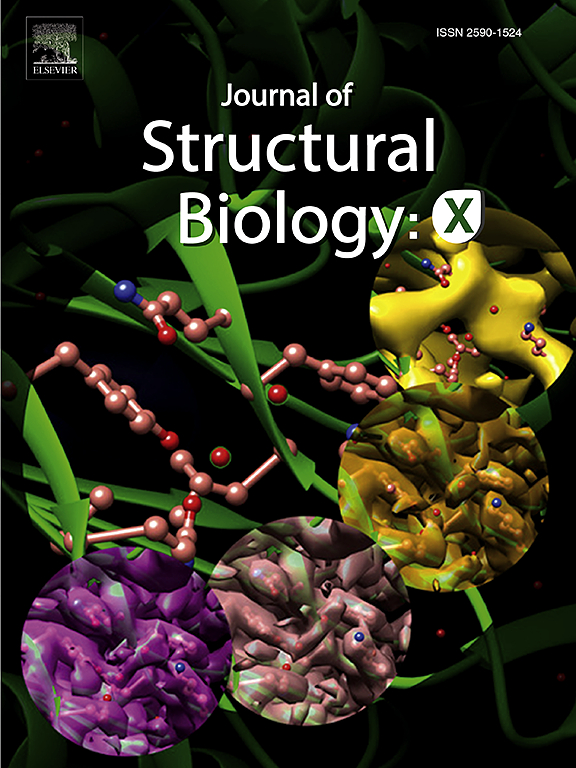CRISP:一个具有条件随机场的低温电镜图像分割和处理的模块化平台
IF 2.7
3区 生物学
Q3 BIOCHEMISTRY & MOLECULAR BIOLOGY
引用次数: 0
摘要
在低温电子显微镜(cryo-EM)显微照片中,从背景中区分信号是一个关键的处理步骤,但由于固有的低信噪比(SNR)、污染物、可变冰厚和密集排列的大小不一的颗粒,仍然具有挑战性。最近的图像分割方法提供了像素级的精度,因此与传统的目标检测方法相比有几个优势:可以计算分割的斑点质量来抑制假阳性颗粒,可以利用全亮度剖面来改善颗粒的定心,并且可以更可靠地识别不规则形状的颗粒。然而,低信噪比使得训练分割模型难以获得准确的像素级注释,并且在缺乏系统评估平台的情况下,大多数分割管道仍然依赖于自定义设计选择。在这里,我们介绍了一个模块化的平台,可以自动生成高质量的分割图作为参考标签。该平台支持分割架构、特征提取器和损失函数的灵活组合,并集成了具有类别区分特征的新型条件随机场(CRFs),将粗预测细化为细粒度分割。在合成数据上,使用我们的参考标签训练的模型实现了像素级的准确率、召回率、精度、交叉超过联合(IoU)和F1分数都超过了90%。我们进一步表明,所得到的分割可以直接用于粒子拾取,从真实的实验数据集产生更高分辨率的3D密度图;这些重建结果与人类专家的结果相匹配,超过了现有的颗粒拾取工具的结果。为了便于进一步的研究,我们将我们的方法作为开源包CRISP发布,可在https://github.com/phonchi/CryoParticleSegment上获得。本文章由计算机程序翻译,如有差异,请以英文原文为准。

CRISP: A modular platform for cryo-EM image segmentation and processing with Conditional Random Field
Distinguishing signal from background in cryogenic electron microscopy (cryo-EM) micrographs is a critical processing step but remains challenging owing to the inherently low signal-to-noise ratio (SNR), contaminants, variable ice thickness, and densely packed particles of heterogeneous sizes. Recent image-segmentation methods provide pixel-level precision and thus offer several advantages over traditional object-detection approaches: segmented-blob mass can be computed to suppress false-positive particles, particle centering can be improved by leveraging the full brightness profile, and irregularly shaped particles can be identified more reliably. However, low SNR makes it difficult to obtain accurate pixel-level annotations for training segmentation models, and, in the absence of systematic evaluation platforms, most segmentation pipelines still rely on ad-hoc design choices.
Here, we introduce a modular platform that automatically generates high-quality segmentation maps to serve as reference labels. The platform supports flexible combinations of segmentation architectures, feature extractors, and loss functions, and it integrates novel Conditional Random Fields (CRFs) with class-discriminative features to refine coarse predictions into fine-grained segmentations. On synthetic data, models trained with our reference labels achieve pixel-level accuracy, recall, precision, Intersection-over-Union (IoU), and scores all exceeding 90%. We further show that the resulting segmentations can be used directly for particle picking, yielding higher-resolution 3D density maps from real experimental datasets; these reconstructions match those curated by human experts and surpass the results of existing particle-picking tools. To facilitate further research, we release our methods as the open-source package CRISP, available at https://github.com/phonchi/CryoParticleSegment.
求助全文
通过发布文献求助,成功后即可免费获取论文全文。
去求助
来源期刊

Journal of structural biology
生物-生化与分子生物学
CiteScore
6.30
自引率
3.30%
发文量
88
审稿时长
65 days
期刊介绍:
Journal of Structural Biology (JSB) has an open access mirror journal, the Journal of Structural Biology: X (JSBX), sharing the same aims and scope, editorial team, submission system and rigorous peer review. Since both journals share the same editorial system, you may submit your manuscript via either journal homepage. You will be prompted during submission (and revision) to choose in which to publish your article. The editors and reviewers are not aware of the choice you made until the article has been published online. JSB and JSBX publish papers dealing with the structural analysis of living material at every level of organization by all methods that lead to an understanding of biological function in terms of molecular and supermolecular structure.
Techniques covered include:
• Light microscopy including confocal microscopy
• All types of electron microscopy
• X-ray diffraction
• Nuclear magnetic resonance
• Scanning force microscopy, scanning probe microscopy, and tunneling microscopy
• Digital image processing
• Computational insights into structure
 求助内容:
求助内容: 应助结果提醒方式:
应助结果提醒方式:


